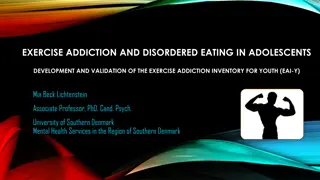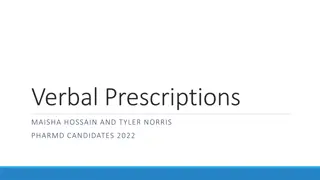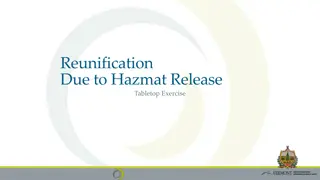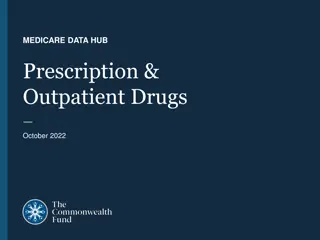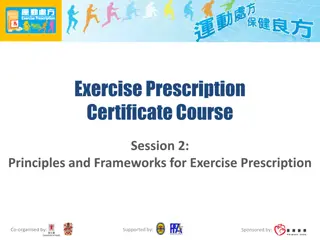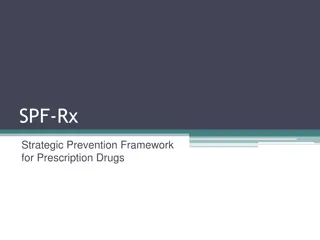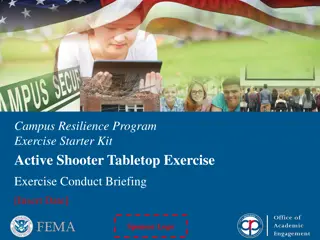Exercise Prescription and Strength Building Strategies
In this comprehensive resource, Becky Owen, a Clinical Specialist in Rehabilitation, shares insights on exercise prescription, strength building goals, hypertrophy, and max strength training guidelines. The content delves into the importance of efficient and effective rehab through exercise, highlighting key concepts such as good movement patterning and skill acquisition. Various squat progressions, ACSM guidelines, and tips on achieving hypertrophy and max strength are discussed alongside the nuances of exercise prescription for elite athletes versus regular individuals. Explore this informative guide for valuable exercise insights.
Download Presentation

Please find below an Image/Link to download the presentation.
The content on the website is provided AS IS for your information and personal use only. It may not be sold, licensed, or shared on other websites without obtaining consent from the author.If you encounter any issues during the download, it is possible that the publisher has removed the file from their server.
You are allowed to download the files provided on this website for personal or commercial use, subject to the condition that they are used lawfully. All files are the property of their respective owners.
The content on the website is provided AS IS for your information and personal use only. It may not be sold, licensed, or shared on other websites without obtaining consent from the author.
E N D
Presentation Transcript
EXERCISE PRESCRIPTION Becky Owen Clinical Specialist in Rehabilitation SMSKP
TAKE HOME MESSAGES Rehab is exercise However much we try to sell activity, rehab or movement, it will always be exercise Strength and conditioning is rehab and prehab Good movement patterning Skill acquisition Good programming drives a specific adaptation to the imposed demands
COULD WE GET BETTER RESULTS? Are we really being efficient? Are we the most effective we could be? Why do so many people prescribe 3 x 10?
How does exercise prescription for an elite athlete differ from someone on ITU? Time under tension
BUILDING STRENGTH What are the goals? 1. Build muscle 2. Build strength 3. Build specific strength 1. Endurance 2. Power 3. Reactive/Plyometric
SQUAT Progression Regression Reduce reps and sets Reduce depth Sit to stand Wall ball squat Bridging Isometric sitting Isometric supine lying Add load Increase repetitions Increase depth Move to an unstable surface Staggered squat/sit to stand Side lunge Lunge Step up Single leg squat Pistol squat
HYPERTROPHY Loading and Volume 3-5 sets 8-12 repetitions OR fatigue 70-85% 1RM Rest Intervals 60-120 seconds Frequency 2-3 times a week
MAX STRENGTH Loading and Volume 3 sets 1-5 repetitions if maximal 6-12 repetitions when sub maximal 85-100% 1RM Rest Intervals 120-180 seconds Necessary to allow for hormonal, cv and metabolic responses Frequency 2-3 times a week Advised 48 hours between sessions
BUILDING POWER Loading and Volume 1-3 sets multi joint 4-6 reps 40-60% 1RM Rest Intervals 120-180 seconds to allow for phosphocreatine replenishment Frequency 2-3 times a week
BUILDING ENDURANCE Loading and Volume 3 sets 15-25 repetitions or fatigue Lighter loads Rest Intervals <60 seconds for 15 reps 60-120 seconds for 25+ reps Frequency 2-3 times a week Can be trained up to 6 x a week
BUILDING BONE DENSITY https://twitter.com/i/status/145266701 1763511296
REFERENCES American College of Sports Medicine Gabriel, D., Kamen, G., & Frost, G. (2006). Neural Adaptations to Resistive Exercise. Sports Medicine, 36(2), 133- 149. doi: 10.2165/00007256-200636020-00004Kraemer, W., & Ratamess, N. (2005). Hormonal Responses and Adaptations to Resistance Exercise and Training. Sports Medicine, 35(4), 339-361. doi: 10.2165/00007256- 200535040-00004 Linnamo, V., Pakarinen, A., Komi, P. V., Kraemer, W. J., & H kkinen, K. (2005). Acute Hormonal Responses to Submaximal and Maximal Heavy Resistance and Explosive Exercises in Men and Women. The Journal of Strength and Conditioning Research,19(3), 566. Rehabilitation. (n.d.) In The Oxford Language Dictionary. Google Selvanayagam, V. S., Riek, S., & Carroll, T. J. (2011). Early neural responses to strength training. Journal of Applied Physiology,111(2), 367-375. Smilios, I., Tsoukos, P., Zafeiridis, A., Spassis, A., & Tokmakidis, S. P. (2014). Hormonal responses after resistance exercise performed with maximum and submaximum movement velocities. Applied Physiology, Nutrition, and Metabolism,39(3), 351-357. Xu, Y., Wang, Y., Chen, J., He, Y., Zeng, Q., Huang, Y., Xu, X., Lu, J., Wang, Z., Sun, X., Chen, J., Yan, F., Li, T., Guo, W., Xu, G., Tian, H., Xu, X., Ma, Y., Wang, L., Zhang, M., Yan, Y., Wang, B., Xiao, S., Zhou, L., Li, L., Zhang, Y., Chen, H., Zhang, T., Yan, J., Ding, H., Yu, Y., Kou, C., Jia, F., Liu, J., Chen, Z., Zhang, N., Du, X., Du, X., Wu, Y. and Li, G., 2020. The comorbidity of mental and physical disorders with self-reported chronic back or neck pain: Results from the China Mental Health Survey. Journal of Affective Disorders, 260, pp.334-341.


